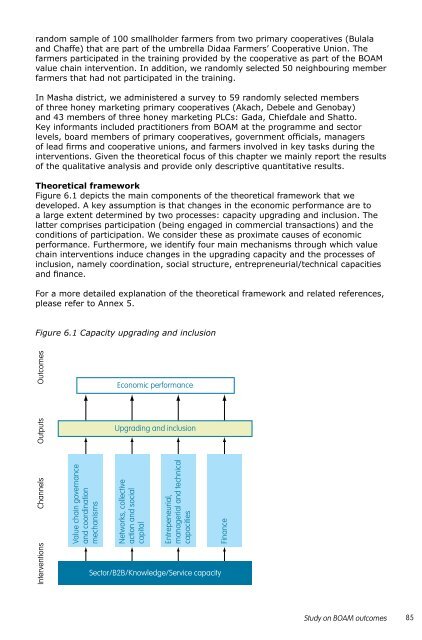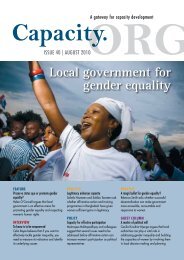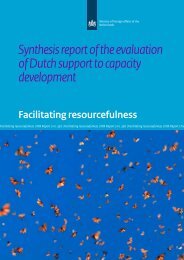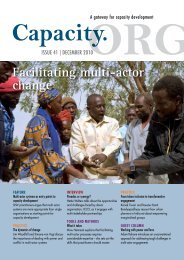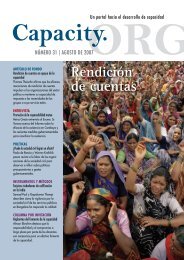Pro-Poor Value Chain Development - Capacity.org
Pro-Poor Value Chain Development - Capacity.org
Pro-Poor Value Chain Development - Capacity.org
Create successful ePaper yourself
Turn your PDF publications into a flip-book with our unique Google optimized e-Paper software.
andom sample of 100 smallholder farmers from two primary cooperatives (Bulala<br />
and Chaffe) that are part of the umbrella Didaa Farmers’ Cooperative Union. The<br />
farmers participated in the training provided by the cooperative as part of the BOAM<br />
value chain intervention. In addition, we randomly selected 50 neighbouring member<br />
farmers that had not participated in the training.<br />
In Masha district, we administered a survey to 59 randomly selected members<br />
of three honey marketing primary cooperatives (Akach, Debele and Genobay)<br />
and 43 members of three honey marketing PLCs: Gada, Chiefdale and Shatto.<br />
Key informants included practitioners from BOAM at the programme and sector<br />
levels, board members of primary cooperatives, government officials, managers<br />
of lead firms and cooperative unions, and farmers involved in key tasks during the<br />
interventions. Given the theoretical focus of this chapter we mainly report the results<br />
of the qualitative analysis and provide only descriptive quantitative results.<br />
Theoretical framework<br />
Figure 6.1 depicts the main components of the theoretical framework that we<br />
developed. A key assumption is that changes in the economic performance are to<br />
a large extent determined by two processes: capacity upgrading and inclusion. The<br />
latter comprises participation (being engaged in commercial transactions) and the<br />
conditions of participation. We consider these as proximate causes of economic<br />
performance. Furthermore, we identify four main mechanisms through which value<br />
chain interventions induce changes in the upgrading capacity and the processes of<br />
inclusion, namely coordination, social structure, entrepreneurial/technical capacities<br />
and finance.<br />
For a more detailed explanation of the theoretical framework and related references,<br />
please refer to Annex 5.<br />
Figure 6.1 <strong>Capacity</strong> upgrading and inclusion<br />
Interventions Channels Outputs Outcomes<br />
<strong>Value</strong> chain governance<br />
and coordination<br />
mechanisms<br />
Economic performance<br />
Upgrading and inclusion<br />
Networks, collective<br />
action and social<br />
capital<br />
Entrepeneurial,<br />
managerial and technical<br />
capacities<br />
Sector/B2B/Knowledge/Service capacity<br />
Finance<br />
Study on BOAM outcomes<br />
85


